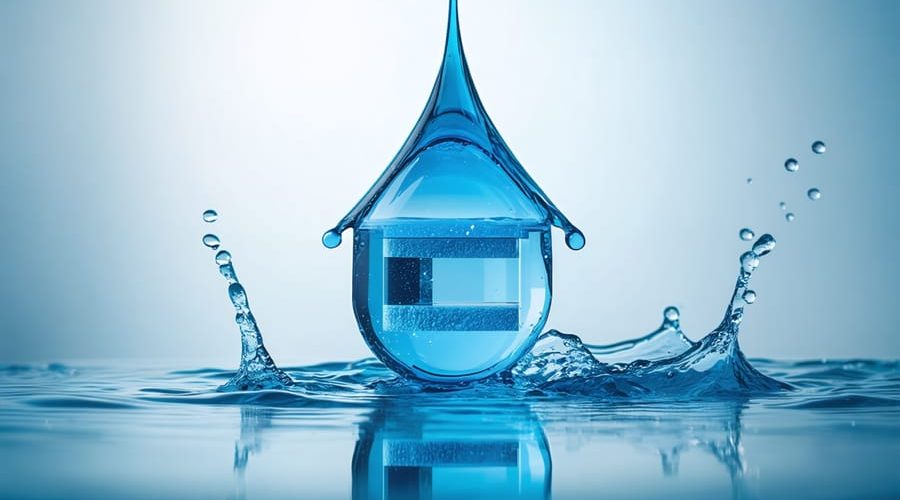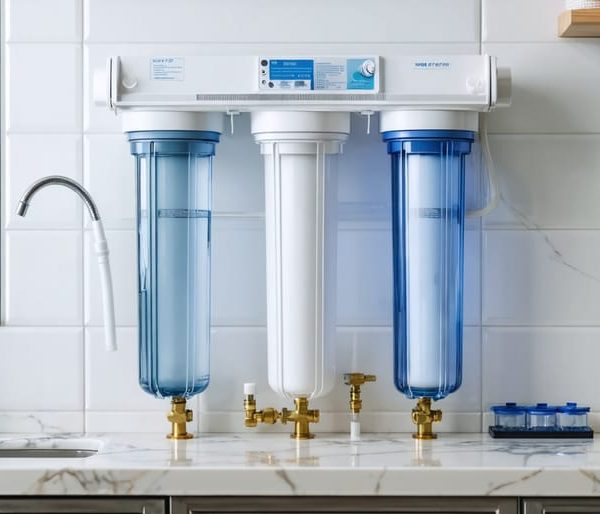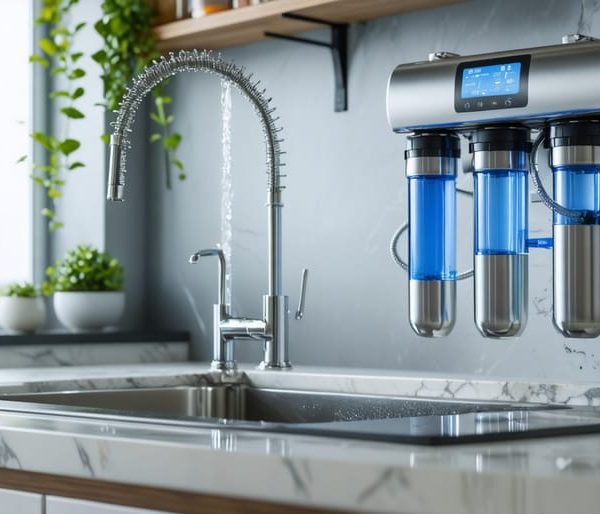Protect your family’s health by removing fluoride from your tap water with advanced home filtration systems that go beyond standard carbon filters. While traditional water filters excel at removing chlorine and sediment, fluoride’s unique molecular structure requires specialized filtration methods to ensure effective removal. Today’s leading reverse osmosis systems and activated alumina filters offer powerful solutions for homeowners concerned about fluoride exposure, delivering laboratory-tested results that match bottled water quality.
Recent studies show that excessive fluoride intake may impact thyroid function and neurological development, making home filtration an increasingly popular choice for health-conscious families. Modern fluoride filters combine multiple filtration stages – typically including reverse osmosis membranes, activated alumina, and bone char media – to remove up to 95% of fluoride while preserving beneficial minerals. These systems provide a sustainable, cost-effective alternative to bottled water, with most units requiring just two filter changes per year for optimal performance.
Whether you’re concerned about dental fluorosis, seeking cleaner drinking water, or simply want more control over your water quality, understanding your fluoride filtration options is the first step toward healthier household water.
Understanding Fluoride in Your Water
Natural vs. Added Fluoride
Fluoride occurs naturally in groundwater and can vary significantly between well water versus city water sources. Natural fluoride forms when water flows through fluoride-containing rocks and soil, with levels typically ranging from 0.1 to 4.0 parts per million (ppm). In contrast, added fluoride in municipal water supplies is carefully controlled, with most systems maintaining a level of 0.7 ppm as recommended by public health authorities.
While natural fluoride exists as calcium fluoride, artificial fluorination typically uses compounds like fluorosilicic acid or sodium fluoride. These added compounds are more readily absorbed by the body compared to naturally occurring fluoride. Understanding this distinction is crucial when selecting a water filter, as different filtration methods may be more effective at removing specific types of fluoride compounds.
For households concerned about fluoride levels, testing your water source can help determine whether the fluoride present is primarily natural or added, allowing for more informed decisions about filtration needs.
Testing Your Water’s Fluoride Levels
Before investing in a fluoride filtration system, it’s important to know your water’s current fluoride levels. You can determine this through several methods. The most reliable option is using a professional water testing kit specifically designed for fluoride detection. These kits typically use colorimetric or electronic testing methods and are available from water quality suppliers or online retailers.
Your local water authority should provide annual water quality reports that include fluoride levels. However, these reports reflect average values and may not precisely match your household’s levels. For more accurate results, you can send a water sample to a certified laboratory for comprehensive testing.
Digital meters offer a convenient way to monitor fluoride levels at home, though they tend to be more expensive than basic testing kits. When testing, always follow the manufacturer’s instructions carefully and take multiple readings for accuracy. If you’re unsure about the results, consider having a professional water quality assessment done to verify your findings.
Remember that fluoride levels can fluctuate seasonally or with changes in your water source, so regular testing is recommended, especially after installing a new filtration system.
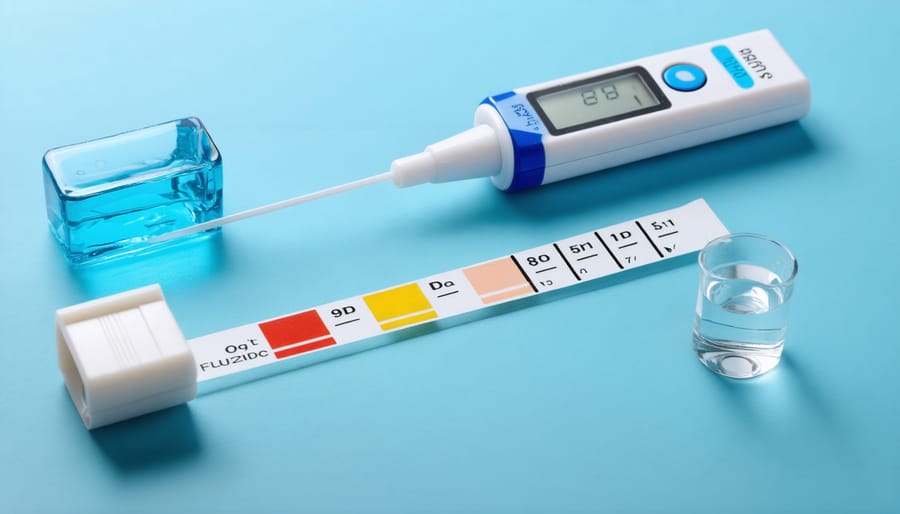
Effective Fluoride Filtration Methods
Reverse Osmosis Systems
Reverse osmosis (RO) systems stand out as one of the most effective methods for fluoride removal, capable of filtering out up to 95% of fluoride from drinking water. Understanding how reverse osmosis removes fluoride involves a sophisticated process where water is forced through a semi-permeable membrane under pressure.
The system’s membrane contains microscopic pores that allow water molecules to pass through while blocking larger particles, including fluoride ions. This process effectively separates pure water from contaminants, creating two streams: filtered water for consumption and wastewater containing concentrated impurities.
What makes RO systems particularly effective is their multi-stage filtration process. Before water reaches the main RO membrane, it typically passes through pre-filters that remove larger particles, chlorine, and sediment. This comprehensive approach not only eliminates fluoride but also addresses other common water contaminants like lead, arsenic, and dissolved solids.
While RO systems require regular maintenance and filter replacements, they provide consistent, reliable fluoride removal for household use. The initial investment may be higher compared to other filtration methods, but the long-term benefits of pure, fluoride-free water make it a worthwhile consideration for health-conscious homeowners. Keep in mind that professional installation is recommended to ensure optimal performance and proper waste water management.
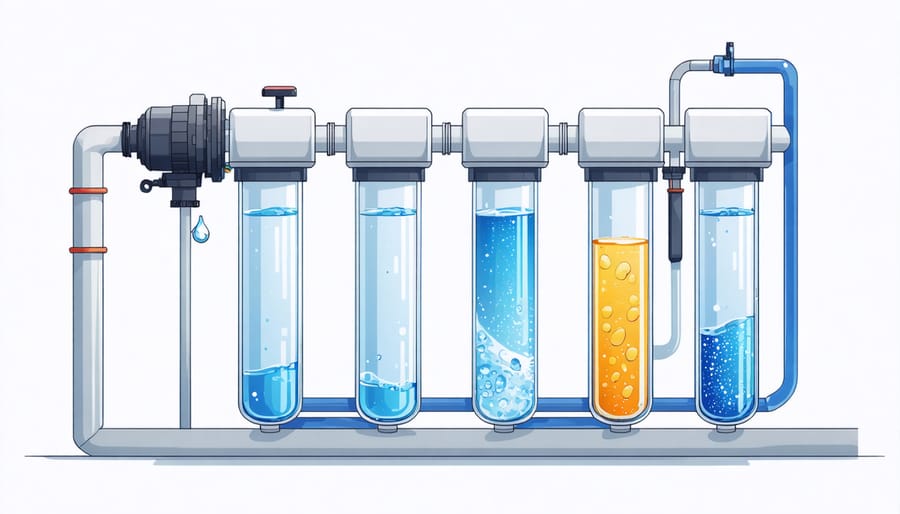
Activated Alumina Filters
Activated alumina filters represent one of the most effective solutions for removing fluoride from drinking water. These filters use highly porous aluminum oxide balls that act like powerful magnets for fluoride ions, attracting and binding them as water passes through the filtration system.
The science behind activated alumina is remarkably efficient, with removal rates typically ranging between 85% and 95% of fluoride content. The process works through adsorption, where fluoride molecules stick to the surface of the alumina particles, leaving your water significantly cleaner and safer for consumption.
What makes activated alumina particularly appealing for home use is its long-lasting performance and cost-effectiveness. A properly maintained filter can effectively treat thousands of gallons of water before requiring replacement. However, it’s important to note that these filters work best within specific pH ranges, typically between 5.5 and 6.5, and may require pre-treatment of your water to achieve optimal results.
Maintenance is relatively straightforward, though the filter media will eventually need replacement once it becomes saturated with fluoride. Regular testing of your filtered water can help determine when it’s time to replace the media. While activated alumina filters do require an initial investment, they provide a reliable and sustainable solution for homeowners concerned about fluoride in their drinking water.
Bone Char Filtration
Bone char filtration stands as one of the most established methods for removing fluoride from water, with roots tracing back centuries. This natural filtration process uses carefully prepared cattle bones that have been heated at high temperatures (around 1,472°F/800°C) in an oxygen-depleted environment, creating a highly porous material with exceptional fluoride-binding properties.
The resulting char works through a process called adsorption, where fluoride ions attach to the surface of the bone char material. This method can remove up to 90% of fluoride from water, making it remarkably effective for home filtration systems. Beyond fluoride removal, bone char also helps eliminate heavy metals and organic compounds, improving overall water quality.
Modern applications of bone char filtration typically involve cartridge-based systems that can be installed under the sink or attached to countertop filters. These systems require periodic replacement of the bone char media, usually every 6-12 months depending on water usage and initial fluoride levels.
While highly effective, it’s important to note that some individuals may prefer alternative methods due to the animal-derived nature of bone char. For those seeking a vegan-friendly option, several plant-based and mineral-based alternatives are available that offer similar fluoride-removal capabilities. Regular testing of filtered water can help ensure the bone char media continues to effectively remove fluoride over time.
Setting Up Your Home Fluoride Filter
Installation Considerations
When selecting and installing a fluoride filtration system for your home, several key factors require careful consideration. First, assess your available space and decide whether you prefer a countertop, installing under-sink water filters, or whole-house system. Each option offers different benefits, with under-sink models providing a clean look while countertop units offer easier installation.
Water pressure is crucial – most fluoride filters require minimum pressure levels to function effectively. Check your home’s water pressure and ensure it meets the manufacturer’s specifications. Additionally, consider the filter’s flow rate, as some systems may reduce water pressure significantly.
Your household’s daily water consumption plays a vital role in choosing the right system size. A family of four typically needs a larger capacity filter than a single-person household. Factor in activities like cooking, drinking, and food preparation when calculating your needs.
Installation location should account for filter cartridge accessibility. Regular maintenance requires easy access for cartridge replacement and system cleaning. Ensure there’s adequate clearance for servicing and that the location is protected from extreme temperatures.
Plumbing compatibility is another essential consideration. Some older homes may need adapter fittings or plumbing modifications to accommodate modern filtration systems. Consider consulting a licensed plumber if you’re unsure about your home’s plumbing configuration or if modifications are necessary.
Lastly, check local building codes and regulations regarding water system modifications. Some areas require permits or professional installation for certain types of water treatment systems.
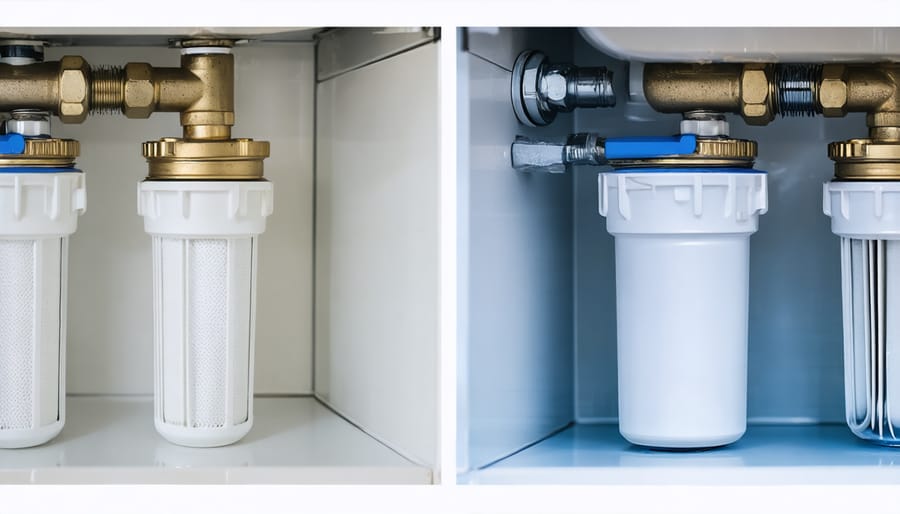
Maintenance Requirements
Maintaining your fluoride water filter is essential for optimal performance and longevity. Following a regular filter replacement schedule ensures consistent water quality and prevents system deterioration.
For most fluoride filters, the primary cartridge should be replaced every 6-12 months, depending on your household’s water usage and local water quality. However, pre-filters may need more frequent changes, typically every 3-4 months, to protect the main fluoride filtering components from sediment and larger particles.
Monitor these key maintenance indicators:
– Decreased water flow
– Changes in water taste or odor
– Unusual noises from the system
– Calendar-based replacement dates
Monthly maintenance tasks include:
– Checking for leaks around connections
– Cleaning external surfaces
– Monitoring pressure gauge readings
– Flushing the system for 2-3 minutes
Some filters require additional care:
– Bone char filters need gentle handling during replacement
– Activated alumina systems benefit from periodic backwashing
– Reverse osmosis membranes need sanitization every 12 months
Keep a maintenance log to track filter changes and system performance. This helps identify patterns and ensures timely replacements. Store replacement filters in a cool, dry place and always wash your hands before handling filter components. Consider keeping spare filters on hand to avoid interruptions in your water filtration system’s performance.
Remember that proper maintenance not only extends your filter’s life but also ensures consistent fluoride removal and safe drinking water for your household.
Cost and Environmental Impact
When considering a fluoride filtration system for your home, it’s important to understand both the financial investment and environmental implications. Initial costs for fluoride-removing water filters typically range from $100 to $500, depending on the system type and capacity. Reverse osmosis systems, while more expensive upfront, often prove cost-effective in the long run when compared to purchasing bottled water.
Maintenance costs should also factor into your budget planning. Filter replacements are necessary every 6-12 months, with replacement cartridges costing between $30-$100 each. While this may seem substantial, the per-gallon cost of filtered water remains significantly lower than bottled alternatives.
From an environmental perspective, home water filtration systems offer several advantages. By filtering tap water, you reduce plastic waste from bottled water consumption. However, some filtration methods, particularly reverse osmosis, can waste water during the filtration process – typically 2-3 gallons for every gallon of filtered water produced. To minimize this impact, consider systems with waste water recycling features or collect the waste water for garden irrigation.
Filter disposal presents another environmental consideration. Most carbon-based filters can be recycled through specialized programs, though aluminum oxide and other fluoride-specific media may require special disposal. Some manufacturers offer take-back programs for used filters, helping to reduce landfill impact.
To optimize both cost and environmental efficiency, regular maintenance is crucial. Proper care extends filter life, reduces waste, and ensures consistent performance. Consider installing a whole-house water meter to monitor usage and filter efficiency, helping you schedule maintenance at optimal intervals.
Choosing the right fluoride water filter for your home is a crucial step toward ensuring cleaner, healthier drinking water for you and your family. Throughout this guide, we’ve explored various effective filtration options, from reverse osmosis systems and activated alumina filters to bone char and gravity-fed solutions. Each method offers unique benefits, with reverse osmosis and activated alumina standing out as the most reliable choices for comprehensive fluoride removal.
Remember that successful fluoride filtration requires proper maintenance and regular filter replacement to maintain effectiveness. When selecting your system, consider factors such as installation requirements, maintenance costs, and your household’s daily water consumption. For optimal results, combine your chosen filtration method with regular water testing to ensure your system continues to perform effectively.
By investing in a quality fluoride filtration system and maintaining it properly, you’re not only improving your water quality but also taking an important step toward a healthier, more sustainable lifestyle. Whether you choose a whole-house system or a countertop solution, the key is to select a certified filter that aligns with your specific needs and maintenance capabilities.
